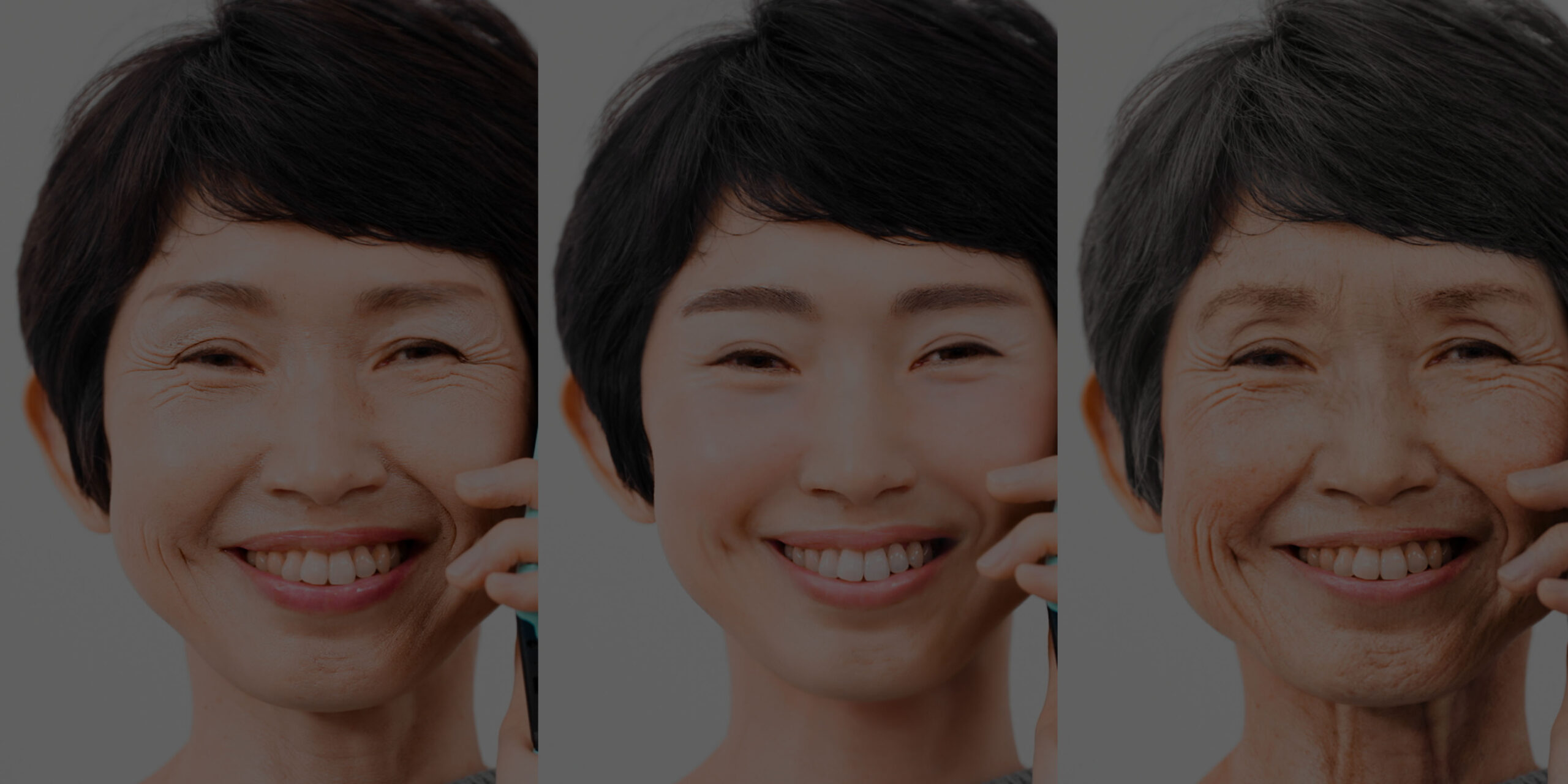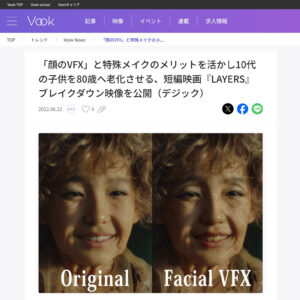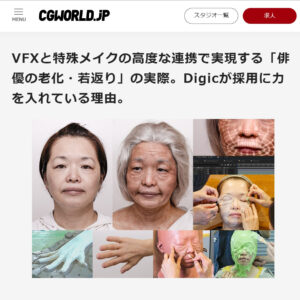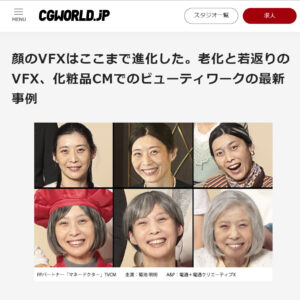Facial VFX features
Applying VFX to a video in which an actor is performing allows them to be de-aged or aged, offering peace of mind to both the actor and director. The actor’s real skin is used, resulting in a natural finish. VFX artists specializing in human anatomy, with a deep understanding of faces, handle the work.
We also provide solutions to the following issues:
– The limited options available when an actor plays a character at different ages in the same production.
– The actor must retain his beard for a role in another production.
– Putting on special makeup is time-consuming causing actor fatigue and reducing filming time.
– Difficulty in acting while wearing special makeup.
– Interruptions during filming for fixing makeup.
– The need for an alternative to digital humans.
Our works
– Warner Bros “Onmyoji Zero”
– Feature film “ABUDEKA is BACK”
– Mizuho Bank “Jumbo Lottery”
– Netflix “Sweet Home season2”
– MITSUBISHI ESTATE “Flying Car”
– Disney “VIGILANTE”
– Earth Corporation “Mondahmin”
– SMBC Nikko Securities Inc.”Future meeting with three Ichiros”
– Unilever “GLOW and LOVELY”
– McDonald “The two of them, unchanged”
– UQ mobile “UQUEEN”
– BETSUDAI “LAYERS”
– JUNG SAEM MOOL “Brand CM”
– SUBARU “FORESTER”
etc.

De-Aging / Aging VFX
The faces of actors can be de-aged or aged. There is no need for special filming techniques or special tools. We will handle all necessary processes requiring expertise, including the gathering of materials prior to filming and photographing of the skin. Experts specializing in faces will make full use of VFX technology to realize all kinds of presentations relating to the face and body.
VFX+Special make up / Beard Erase / Skin Creation
If you wish for a dramatic change, such as aging a teenager to their 80s, we recommend the combined use of facial VFX and special makeup. This allows retaining of the advantages of special makeup, while reducing makeup time and achieving high-quality in the finish. We can also remove beards from actors who cannot shave. We can create skin that closely resembles the actor’s own skin for high-quality beauty retouching.
Articles – Japanese –
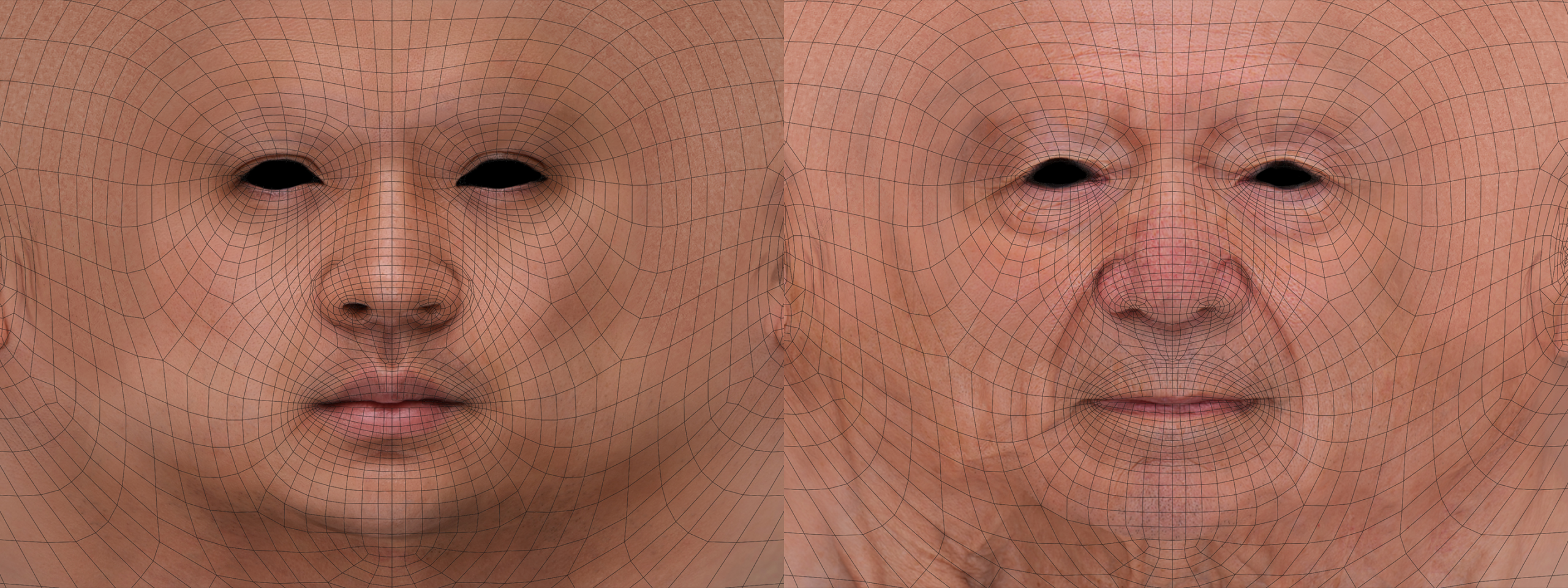
Procedure prior to filming
Procedure prior to filming (example)
- Meeting
- Gathering materials and setting goals
- Test filming
- Delivery of test footage
- Preparations for the main shoot
Below are the benefits of test filming:
- he footage can be used as explanatory material for the actor and other stakeholders
- Provides peace of mind to the actor
- Allows ascertainment of wigs and other items needed prior to filming
- The footage can be used during discussions with hair and special makeup artists
(contact us for details on the numerous other benefits)
※We implement strict confidentiality and security measures.
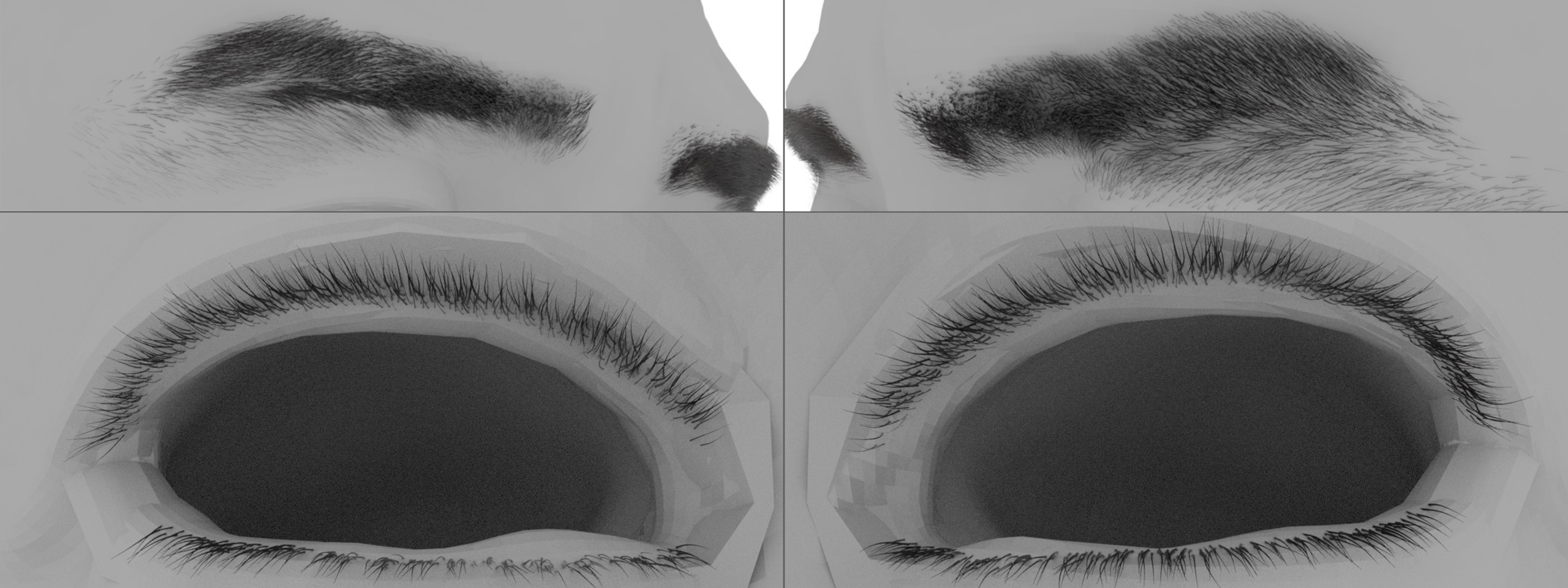
Tech Note
This Tech Note is for those who want to know how to proceed with Facial VFX for a project without having to ask for help, and for those who are interested in facial VFX.
On this page, you can know the following;
– How to proceed with “De-Aging/Aging VFX
– What you should do before and during shooting
– How to use Facial VFX, which is still known only by a few people
We have tried to explain the process as simply as possible, so we hope you will find it easy to read.
In order to make this technology something that can be used in a wide range of film productions, we need to make it affordable and ensure that it can be used within a reasonable production timeframe.
In order to achieve results that satisfy our clients on the difficult theme of “human faces”, even in 2024 it is still necessary to spend a lot of money and have a long production timeframe. We are working to alleviate this difficult situation through technological development and our approach to production.
Nowadays, even for productions with tight schedules, Facial VFX is being used, and it is not uncommon for actors to play various ages. We will continue to aim for Facial VFX to become the natural alternative to stand-ins and special makeup.
The greatest strength of Facial VFX is that “the VFX is applied to footage of the actor performing”. Because it makes the most of the actor’s performance, both the actor and the director can rest assured. We do not create faces using CG from scratch, and then have animators create facial performances while watching the actor’s previous work. The movements of the human face are delicate and complex. It is extremely difficult for someone else to create the facial movements that the actor feels comfortable with.
Facial VFX can also be used to increase the number of films in which actors can appear. Even if you can’t appear in another film because you can’t shave your beard while you’re filming, we can create an actor’s face with no beard.
At Digic, we have a “skin library” with a wide range of skin data. This is because it is possible to create “the person’s own skin” using this library and the skills of our facial VFX artists.
We will solve any problems you have with “faces and bodies” in movie.
– Developing the muscles of the actor’s body
– Creating skin for bald heads and wigs for bald heads
– Skin adjustment and makeup for high-definition images such as 8K
– Creating skin that looks good when you’re in good shape
– Reducing the eeriness of “faces generated by AI
There are more requests for faces and bodies in film production than you might expect. We are continuing to develop in order to meet all of these requests.
Aging
This section explains the “recommended process for Aging VFX” for film makers and the “benefits” of using facial VFX to age actors’ faces.
The benefits of aging with Facial VFX, rather than special makeup or AI apps
When they need to make actors/celebrities look old for movies or commercial films, many filmmakers think of “special makeup” first. Facial VFX is a new technology, so it is still not very well known.
We will compare and explain the characteristics of special makeup and Facial VFX.
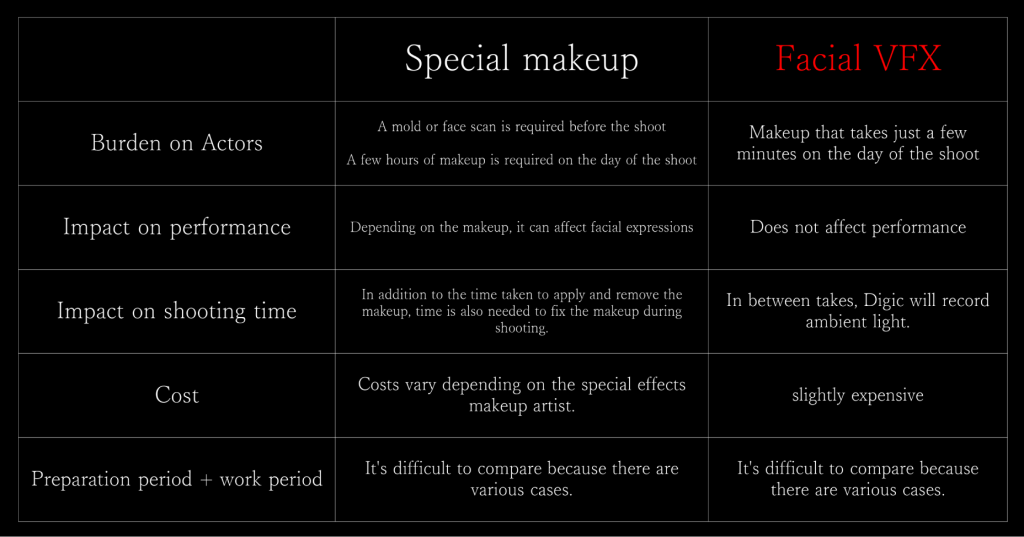
In addition to special makeup and facial VFX, some people may also think of AI as an option.
We also use AI, but whether or not AI can output the aging that the client is really looking for is somewhat down to luck. It is very risky to adopt a method that relies on luck for work with a deadline.
Facial VFX artists can understand the project and story, and accurately create the aging that the client is looking for.
We have worked on various types of aging.
– Healthy and happy-looking old people
– Sick and unhappy-looking old people
– Aging while retaining the person’s characteristics
Since the aging required for each project is different, the ability to accurately grasp the type of aging the client is looking for and to visualize it is required. This ability also includes the ability to appropriately carry out the process of giving form to the client’s image.
Digic is also particular about this process, and by repeating improvements over and over again, we have been able to make our clients happy not only with the final image but also with the way we work.
When we train our Facial VFX artists, we not only train them in creating images, but also in understanding what the client is looking for.
The “process from meeting to completion” that we recommend when Aging VFX is required.
Each process is explained in detail.(Only the “differences” in the flow of De-Aging VFX are in blue.)
- Meeting
- Collecting materials
- Shooting for the VFX test work
- Aging VFX test work
- Delivery of test results
- Meeting
- Preparations before shooting
- Shooting
- Editing
- Aging VFX work
- Checking the finish
- Final delivery
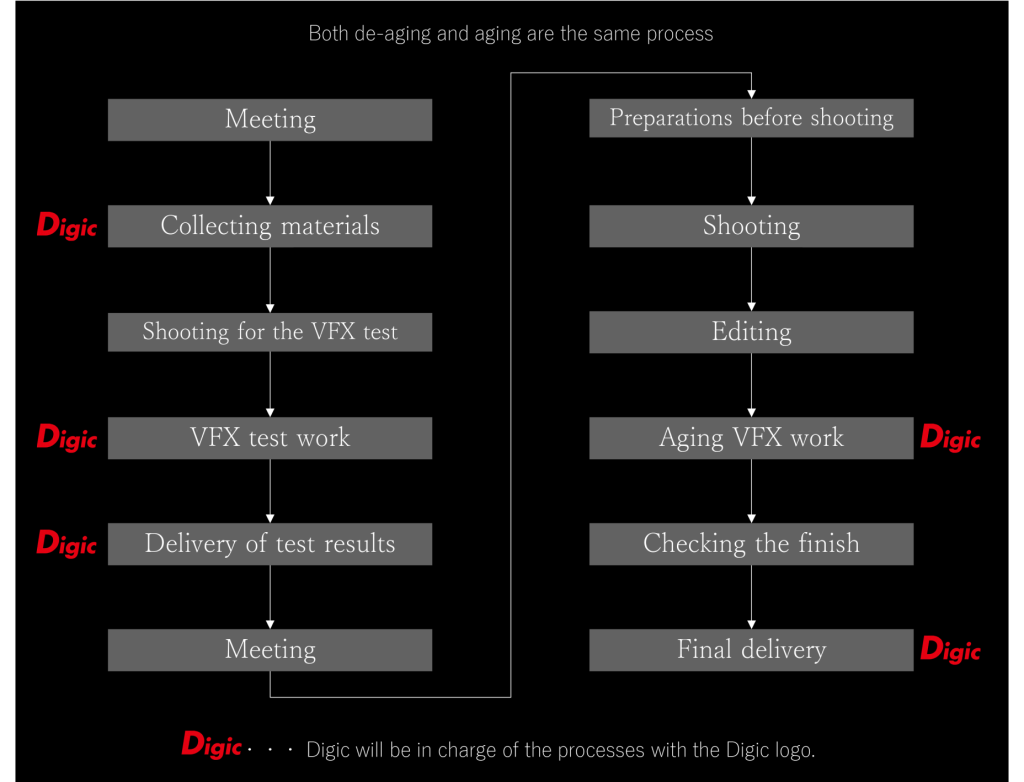
- Meeting
After reading the script, storyboards, project proposal, etc., and seeing the “current photo” of the person who will be aging, we will ask you for your detailed requirements. There are various directions that aging can take, so we will carefully ask you what kind of aging you are looking for.
If you can also tell us the number of shots you expect, the angle of view, and the overall schedule, we can give you our recommendations, the number of working days, and a quote.
It is also possible to have a meeting while watching examples of aging VFX.
Please be assured that Digic takes strict measures to protect confidentiality and security in all projects.
- Collecting materials
If you have already collected materials and have photos of the elderly that are close to or exactly what you are looking for, please give them to us. If you have not yet collected materials and do not know how to do so, we can collect the materials for you.
After we have heard in detail about the aging you are looking for, we will narrow down the target faces from the collected materials and optimize the images that have been selected. This process will enable us to create images that match the image in the client’s mind.
- Shooting for the VFX test work
We recommend that you film for the purpose of conducting Aging VFX tests. We will then carry out Aging VFX tests on the footage you have filmed.
The reasons we recommend Aging VFX tests are,
– You will know what you need to prepare before the actual filming (especially for things like wigs and hair and makeup)
– You will know whether you will need to age other parts of the body besides the face, such as the neck, hands and feet
– You can use the test results as reference materials to explain to the people involved
Ideally, the test should be carried out using the same or similar “lens, angle of view and lighting” as the actual shoot, but if this is difficult, we recommend using the same “lens and angle of view” as the actual shoot. This is because the “shape of the face” changes depending on the lens and angle of view, and this is an essential element for carrying out the VFX test.
Please have the actor perform under the above conditions and provide us with the recorded footage.
In order to make this testing process more effective, we also recommend the following four points
a) Have the actor perform the lines and actions that will be used in the project
b) Use foundation to control shine on the skin
c) Prepare several wig options and have the actor try them on
d) We also have elderly people participate, and after the actor’s recording, we have them perform the same actions and record them
We often get asked the question, “Is it better to use a wig or CG for the hair? We recommend either a wig or hair coloring, based on the three factors of final quality, cost, and work period.
We sometimes create eyebrows and eyelashes using CG, and sometimes we ask the makeup artist to color the actor’s own hair gray or white. We listen to your requests and let you know the best method.
- Aging VFX test work
Once Digic has received the filmed data, we will begin by analyzing the actor’s face. We will analyze the actor’s facial features and the way the facial muscles move in detail.
We can work on all the filmed shots, but we can also tell you the work content that is necessary and sufficient as a test process after hearing your desired completion date and cost.
From the shots that have been filmed, we will select the shots and seconds to be tested, and you will be able to view the footage. Once you have given the go-ahead for the VFX work on that footage, we will begin the aging VFX test.
The test work on the video will be completed in 10 days for 3 seconds, and 18 days for 9 seconds. By increasing the number of facial VFX artists, we can also shorten the work period.
If it is difficult to secure a schedule for the test work, you can also choose 1 to 3 frames from the filmed footage and perform VFX work on the still images. This can be delivered in 3 to 5 days per frame.
- Delivery of test results
- Meeting
- Preparations before shooting
We will show you the completed aging VFX footage and have a meeting to prepare for the actual shooting.
After watching the test results, there were several times when we thought it would be better to change the “hair”, “eyebrows”, “make-up” or “acting”. Being able to make these kinds of discoveries is one of the benefits of doing test work. In particular, you need to be careful because it takes time to prepare a wig.
In most cases, there are no problems with the test results, and we can move straight on to the actual shooting.
- Shooting
If requested, we will be present during shooting. Until shooting begins, we will watch as the actors have their wigs fitted and makeup applied.
After each shot, we will ask you to film just the background without the actors.
After that, we will take 2-3 minutes to shoot for VFX.
We will bring in the color chart, gray + mirror ball, and 360-degree camera.
It is difficult to change the “posture and movement” of the actor using facial VFX, so we will keep a close eye on this during the shooting.
We would like to receive the information on the camera and lens used for the shooting, so please send it to us at a later date.
- Editing
We often receive the question, “Should I give you the data before color correction?
We recommend that you send us the data after color correction/color grading has been carried out, and that we then carry out the Facial VFX work on that. The reason for this is that the “color and skin tone of the face” is an important element in Facial VFX. We also want to create natural aging while carefully preserving the colors that have been created for the background and the people in the color correction/color grading process.
It is also possible to perform Facial VFX work using Log footage and LUTs.
If the number of days available for Facial VFX work is reduced after final grading, we recommend this approach. This is because a significant reduction in the number of days available for work will directly lead to poor results.
- Aging VFX work
Once we have received the OpenEXR/DPX sequence files for the work, we will begin the Facial VFX work.
In order to ensure a smooth start to the work, we ask for the following cooperation
・Please separate the folders for each shot
・If there are any elements that require explanation, please attach a text with the explanation
・If Facial VFX work is required for extra frames, please let us know in advance
The detailed schedule for this process is usually decided by discussing it with the client before the actual filming. Facial VFX work will proceed according to the agreed schedule.
If there are multiple shots, we will discuss the priority order in advance, and will start work on the shots with the highest priority, checking them as they are completed. Once we have received approval from the decision-maker, we can start work on the remaining shots.
- Checking the results
We will complete the shots in order of priority, so please check the results as they are completed.
We will also prepare split-screen (before/after) movies for comparison, so you can show them to the director and actors as they are.
As Facial VFX is a very detailed process, we recommend that you check it in the best possible viewing environment. If the director or actors have any requests regarding the result, we will work on those and provide you with the data for checking again.
- Final delivery
Once we have received your approval for all the shots, we will carry out a quality check of all the shots and make any final adjustments.
We sometimes receive requests asking if it would be possible to deliver the completed shots in order.
Of course, it is possible to deliver the completed shots. However, we strongly recommend that you allow us to perform a quality check and final adjustment of all the shots. This is a detailed explanation of the aging VFX completion process. If you know this much, you can use Facial VFX with peace of mind.
How to age an actor while retaining their unique characteristics
The aging we work on varies, but it can be summarized into two types of requests.
a) A request to age the person while retaining their characteristics
b) A request to create a convincing face based on evidence and data
The overwhelming majority of requests for film and commercial production are for “a”. In this article, we will explain “a” in detail, so we would like to explain “b” first.
An easy-to-understand example of “b” is a request like “Could you help us with the investigation of a criminal? We have a photo of the criminal’s face from 10 years ago, so could you make an aged version of this face for us?
The aging we create is fictional. We can create a face that gives the impression of ‘the wrinkles here are going to get deeper’ based on the subject’s facial expressions and the way they use their facial muscles, but this is just an estimate and is not very accurate.
When we receive requests to help with criminal investigations, we explain the above and decline.
If the request is “I want to gain the sympathy of the audience, even if it’s not very accurate”, then we can accept it.
Now, let’s move on to the first point, “the desire to age while retaining the person’s characteristics”.
We think the interest of those reading this is in the method of “how to age while retaining the person’s characteristics?”. We will introduce some of the methods this time.
The introduction to “aging from a child before puberty to an adult/middle-aged/elderly person” is too complicated and would be too much of a burden for everyone to understand, so it is not introduced in this article.
(The skeleton also changes significantly when you reach puberty. It is not uncommon for a person’s face to change completely when they grow up from a child to an adult. Even with this tendency, if you want to “age while retaining the person’s characteristics”, you need a different approach.)
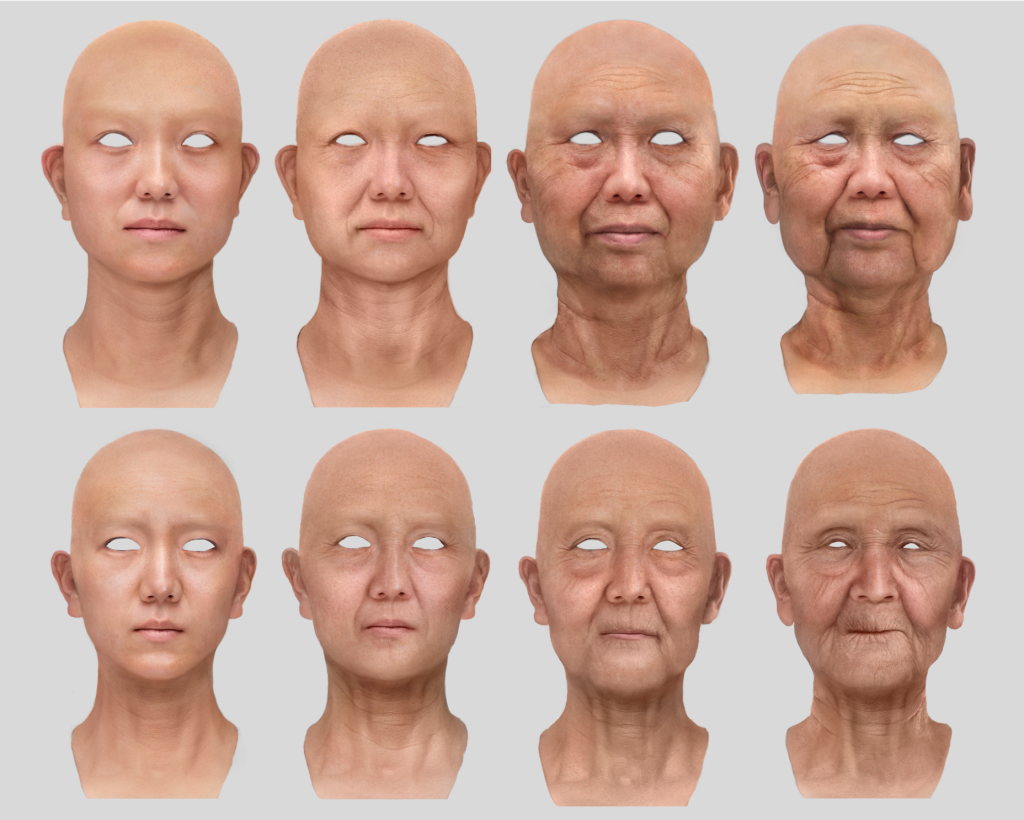
> Recommended Aging Method
In order to age actors while retaining as many of their facial features as possible, we recommend that you do not change the following as much as possible.
・The shape of the eyebrows, eyes, nose and mouth
・The outline, and the relative positions of the eyebrows, eyes, nose and mouth
The parts of the body that do not lose their distinctive features even if they change significantly are the neck, forehead, cheeks and ears. Please add wrinkles and sagging skin to these parts first. In particular, aging the neck is very effective, so we recommend aging the neck first.
From here, we will explain the process from the top of the head down.
> Hair
Even if you make big changes to the actor’s hair, their distinctive features will still remain, so feel free to make the changes you like.
Dark hair makes people look younger, so try changing it to gray hair or reducing the amount of hair. Changing the hair is a very important part of the process, as it allows you to create various aging effects.
> Eyebrows, wrinkles between the eyebrows, and the area around the eyes
The sagging of the fat from above the eyebrows to the upper eyelid or the hollows around the eyes caused by aging can make a person lose their individuality if they are not carefully adjusted.
It is recommended that you prioritize the aging of other parts of the face without making too many changes to these areas.

Even if the shape of the eyebrows is left as it is, you can create an aged impression by reducing the density of the hair and changing the color of the hair towards grey. If you want to make someone who already has wrinkles between their eyebrows look older, you can also make the wrinkles look deeper. Please be careful with the amount you add, as this will make the person look stern.
We recommend adding/deepening the wrinkles at the corners of the eyes, and emphasizing the bags under the eyes and the nasolabial folds. These are areas where you can express aging without losing the person’s distinctive features.
> Nose and ears
If you want to retain the characteristics of an actor, it is probably best not to do much about the “drooping nose” that comes with aging. The ears also droop with age, but since not many people pay attention to the ears, you can probably lower the priority of this area.
> Lips and mouth area
As people age, their lips lose their thickness and become long and narrow, and the space between the tip of the nose and the upper lip also widens.
As people age, the indentation of the philtrum becomes shallower and less noticeable. This change does not detract too much from a person’s features, so it is a change that can be adopted.
Around the mouth, the depth of the wrinkles of the nasolabial folds and marionette lines, as well as the fine wrinkles that accompany them, can be used to control the strength of the aging process. Aging can be further enhanced by adding fat drooping around the cheeks, nasolabial folds and marionette lines.
> Chin area
By adding fat to the chin area and blurring the line between the chin and neck, you can accentuate the appearance of aging. If you want to create an image of an older person who is thin, you should control aging with the skin on the neck, without adding fat to the chin area.
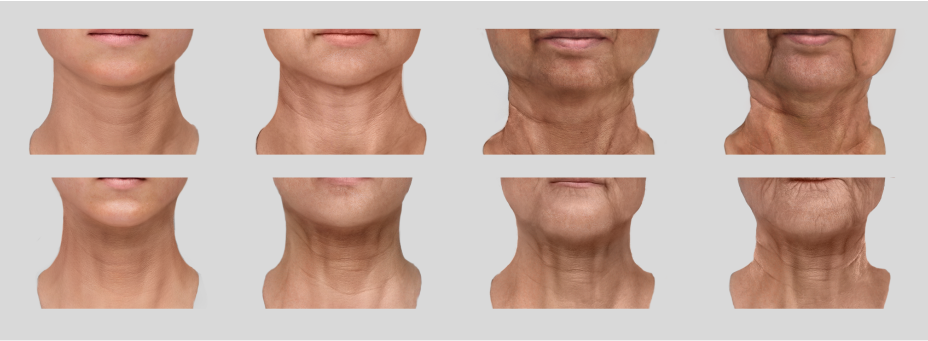
> Neck
The neck of an older person with a thin neck can be expressed by enhancing the hollows adjacent to the sternocleidomastoid muscle. Wrinkles that cross the neck can be seen in many people of all ages. In the case of younger people, these wrinkles are shallower, and they become deeper as the person ages. The aging of the neck can be expressed by the sagging of the skin between these horizontal wrinkles and the accompanying fine wrinkles.
> Skin
We have a library of photographs of people of various ages. We select the one that is closest to the target from this library, and then process it to match the work, creating the skin of the elderly person we are aiming for.
It would take too long to create skin that looks so real from scratch, so we use this method.
We think it’s rare for people to have a library like this, so if you want to age the skin of someone in a photo you have, We recommend being aware of the following when processing it.
> Youth to early adulthood
For men, this is the age when there is a lot of sebum. We will enhance the highlights in areas where the light is strong and add a sheen. By making the skin texture and pores visible in the mid-tones between the highlighted and shaded areas, we can create a difference from childhood. Please add any rashes, acne scars, sunburn spots, freckles, etc. as you like.
For women, some people have little sebum and wear makeup, so they will appreciate an expression that looks sleek skin, rather than glossy skin. By gradually changing the brightness from the highlighted areas to the mid-tones, you can make it look shiny, rather than shiny. We can control the aging process by using makeup to hide large wrinkles and the degree of sagging fat. (This is a complicated topic, so we won’t be discussing “makeup and aging” in this article.)
> Skin of the elderly
As people get older, the amount of sebum secreted by the skin tends to decrease, so you should tone down the shininess and glossiness of the skin, and avoid using sharp highlights that stand out too much.
As people get older, their skin becomes thin and translucent, and things like blood vessels, birthmarks and rashes become more noticeable. The reason you can sometimes see purple or blue in the skin tone is that the deeper layers of the skin are faintly visible.
Some elderly people have skin that is unusually smooth and silky, perhaps because they have been rubbing their skin for many years. It’s also good to add expressions like this. While blemishes and pores are effective for expressing aging, they can give a dirty impression, so be careful with how much you use them.
That’s all for the commentary.
This time, we have introduced methods that are easy to approach for those who want to try aging processing.
New recruits who join Digic and undergo training will acquire more knowledge than what we have introduced here, as well as the skills to visualize it. If you have read this and would like to become a Facial VFX artist, please feel free to apply.
De-Aging
This section explains “recommended process for De-Aging VFX”, “collecting materials”, and “using AI” for film makers.
The advantages and disadvantages of facial VFX “De-Aging”
First, I would like to reveal the weaknesses.
Facial VFX cannot be done without footage of the actor performing. In other words, it is not the best option for projects that involve reviving deceased actors or celebrities.
Next, let’s look at the advantages.
The fact that there is footage of the actor performing and the director giving the OK is an important factor in the “check/decision” process after the VFX work.
When the director checks the footage that the CG company has worked on, they compare it to the “unprocessed, pre-work footage”. This “pre-work footage” has a greater impact on the evaluation than you might expect.
If the performance is different from the “before-work footage”, it will be rejected.
If the position and movement of the face is different from the “before-work footage”, it will be rejected.
You may have already noticed.
Facial VFX works on the footage itself that the actor has performed and the director has given the OK.
This allows us to deal with the aging that needs to be changed without changing the performance that should not be changed.
Here is an example of the opposite.
This is a method of creating a CG image of an actor’s face when they were young, from scratch, without using any footage of the actor performing that the director has approved.
Even if the actor’s younger face can be reproduced with precision, the most difficult part is the process of creating the facial expressions and acting. The CG artist recreates the acting while watching the video used as a reference. The process of the director checking and giving revision instructions is also very difficult and burdensome.
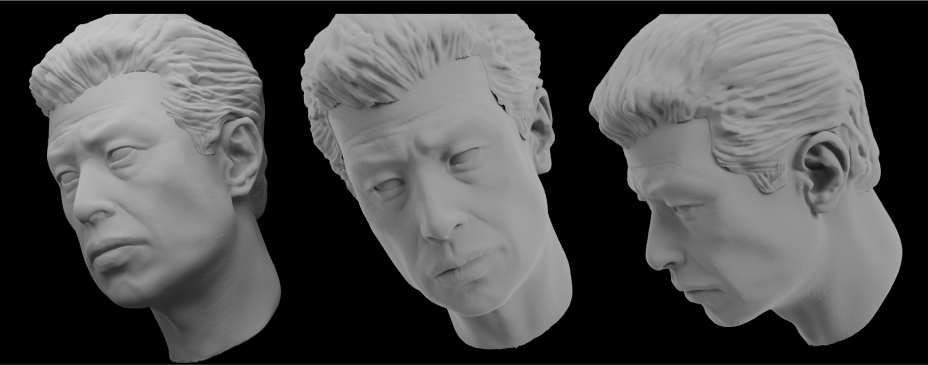
We also sometimes create the faces of actors from scratch using CG.
This is because if there is a significant change in the face between the present and when they were young, it is difficult to achieve de-aging using only footage of the actor in their current appearance. However, even in this case, we try to keep the parts that use CG to a minimum. We do not replace the entire face with CG.
As engineers, we have a desire to “surprise people with technology”. However, the most important thing is to “not disturb the sense of immersion” of the audience.
If the audience is immersed in the story, but then becomes distracted by the CG in a certain scene and loses track of the story, that scene has failed.
We always remind ourselves that the first priority is for the audience and viewers to enjoy the work, and that the technology used in it should not become an end in itself.
To be honest, there have been times when our lack of skill has prevented the audience from being fully immersed in the scene. People are very sensitive to the difference between real and fake people. If the skin feels fake, it’s a failure.
There is still room for improvement in our technology, and there are many themes that need to be developed. The skills of the facial VFX artists also need to be further honed. Looking at the development situation of our overseas rivals, “de-aging of actors’ faces” is still in the developmental stages worldwide.
The “process from meeting to completion” that we recommend when De-aging VFX is required.
Each process is explained in detail.(Only the “differences” in the flow of Aging VFX are in red.)
- Meeting
- Collecting materials
- Shooting for the VFX test work
- Aging VFX test work
- Delivery of test results
- Meeting
- Preparations before shooting
- Shooting
- Editing
- Aging VFX work
- Checking the finish
- Final delivery

- Meeting
After reading the script, storyboards, project proposal, etc., and seeing the “current photo” of the person who will be de-aging, we will ask you for your detailed requirements.
If you can also tell us the number of shots you expect, the angle of view, and the overall schedule, we can give you our recommendations, the number of working days, and a quote.
It is also possible to have a meeting while watching examples of de-aging VFX.
Please be assured that Digic takes strict measures to protect confidentiality and security in all projects.
- Collecting materials
If you have already collected images and photos of the actor when they were young, please give them to us. If you have not collected any materials yet and do not know how to go about it, we can collect the materials for you.
It is important to narrow down the target face from the collected materials. As you will notice when you collect a large number of materials, the face of an actor can often change depending on the work they appear in during the same year. Some actors even gain or lose weight in a matter of months. If you have multiple target faces, it will be impossible to make a plan, so you will need to narrow it down.
- Shooting for the VFX test work
We recommend that you film for the purpose of conducting Aging VFX tests. We will then carry out De-aging VFX tests on the footage you have filmed.
The reasons we recommend De-aging VFX tests are
・The combination of camera angles and acting that completely eliminates the impression of an old person can be found in advance.
・You will know what you need to prepare before the actual shooting (especially for things like wigs and hair and makeup)
・You will know whether you will need to de-age other parts of the body besides the face, such as the neck, hands and feet
・You can use the test results as reference materials to explain to the people involved
We will explain the combination of camera angles and acting that cannot completely erase the impression of aging.
If the “sagging of the actor’s face” is more pronounced than when they were younger, then lowering the face will accentuate this sagging even more due to gravity. Depending on the combination of certain acting and camera angles, this sagging face will be accentuated even more, and even with our technology, it will be impossible to “completely eliminate the impression of aging”.
Ideally, the test should be carried out using the same or similar “lens, angle of view and lighting” as the actual shoot, but if this is difficult, we recommend using the same “lens and angle of view” as the actual shoot. This is because the “shape of the face” changes depending on the lens and angle of view, and this is an essential element for carrying out the VFX test.
Please have the actor perform under the above conditions and provide us with the recorded footage.
In order to make this testing process more effective, we also recommend the following four points
a) The actors are asked to watch a video of themselves when they were young in advance.
b) Have the actor perform the lines and actions that will be used in the project
c) Use foundation to control shine on the skin
d) Prepare several wig options and have the actor try them on
e) After shooting the actor, please have someone whose face is similar to the actor’s when he was young perform the same action and shoot it.
We often get asked the question, “Is it better to use a wig or CG for the hair? We recommend either a wig or hair coloring, based on the three factors of final quality, cost, and work period.
We sometimes create eyebrows and eyelashes using CG, and sometimes we ask the makeup artist to color the actor’s own hair black. We listen to your requests and let you know the best method.
- De-Aging VFX test work
Once Digic has received the filmed data, we will begin by analyzing the actor’s face. We will analyze the actor’s facial features and the way the facial muscles move in detail.
We can work on all the filmed shots, but we can also tell you the work content that is necessary and sufficient as a test process after hearing your desired completion date and cost.
From the shots that have been filmed, we will select the shots and seconds to be tested, and you will be able to view the footage. Once you have given the go-ahead for the VFX work on that footage, we will begin the de-aging VFX test
The test work on the video will be completed in 21 days for 3 seconds, and 28 days for 9 seconds. By increasing the number of facial VFX artists, we can also shorten the work period.
If it is difficult to secure a schedule for the test work, you can also choose 1 to 3 frames from the filmed footage and perform VFX work on the still images. This can be delivered in 9 to 12 days per frame.
- Delivery of test results
- Meeting
- Preparations before shooting
We will show you the completed de-aging VFX footage and have a meeting to prepare for the actual shooting.
After watching the test results, there were several times when we thought it would be better to change the “hair”, “eyebrows”, “make-up”, “acting” or “camera angle”. Being able to make these kinds of discoveries is one of the benefits of doing test work. In particular, you need to be careful because it takes time to prepare a wig.
In most cases, there are no problems with the test results, and we can move straight on to the actual shooting.
- Shooting
If requested, we will be present during shooting.
Until shooting begins, we will watch as the actors have their wigs fitted and makeup applied.
After each shot, we will ask you to film just the background without the actors.
After that, we will take 2-3 minutes to shoot for VFX.
We will bring in the color chart, gray + mirror ball, and 360-degree camera.
It is difficult to change the “posture and movement” of the actor using facial VFX, so we will keep a close eye on this during the shooting.
We would like to receive the information on the camera and lens used for the shooting, so please send it to us at a later date.
- Editing
We often receive the question, “Should I give you the data before color correction?
We recommend that you send us the data after color correction/color grading has been carried out, and that we then carry out the Facial VFX work on that. The reason for this is that the “color and skin tone of the face” is an important element in Facial VFX. We also want to create natural de-aging while carefully preserving the colors that have been created for the background and the people in the color correction/color grading process.
It is also possible to perform Facial VFX work using Log footage and LUTs.
If the number of days available for Facial VFX work is reduced after final grading, we recommend this approach. This is because a significant reduction in the number of days available for work will directly lead to poor results.
- Aging VFX work
Once we have received the OpenEXR/DPX sequence files for the work, we will begin the Facial VFX work.
In order to ensure a smooth start to the work, we ask for the following cooperation
・Please separate the folders for each shot
・If there are any elements that require explanation, please attach a text with the explanation
・If Facial VFX work is required for extra frames, please let us know in advance
The detailed schedule for this process is usually decided by discussing it with the client before the actual filming. Facial VFX work will proceed according to the agreed schedule.
If there are multiple shots, we will discuss the priority order in advance, and will start work on the shots with the highest priority, checking them as they are completed. Once we have received approval from the decision-maker, we can start work on the remaining shots.
- Checking the results
We will complete the shots in order of priority, so please check the results as they are completed.
We will also prepare split-screen (before/after) movies for comparison, so you can show them to the director and actors as they are.
As Facial VFX is a very detailed process, we recommend that you check it in the best possible viewing environment.
If the director or actors have any requests regarding the result, we will work on those and provide you with the data for checking again.
- Final delivery
Once we have received your approval for all the shots, we will carry out a quality check of all the shots and make any final adjustments.
We sometimes receive requests asking if it would be possible to deliver the completed shots in order.
Of course, it is possible to deliver the completed shots. However, we strongly recommend that you allow us to perform a quality check and final adjustment of all the shots.
This is a detailed explanation of the de-aging VFX completion process.
If you know this much, you can use Facial VFX with peace of mind.
Collecting materials and analyzing faces
The most important process is “material collection and facial analysis”. This is the first process, but it is not an exaggeration to say that it affects the final result.
We have spent more than three years making numerous improvements to the “material collection and facial analysis” process. In this article, we will introduce some of the material collection and facial analysis.
When we receive a request to make an actor look younger, we order up the actor’s past works and photo collections. Facial VFX requires more video materials than still images. This is because video materials often capture the actor’s face from various angles.
There is no such thing as too much video material, as it is also used as reference for changes in facial expression. The reason why still image materials such as photo collections are necessary is to check the details of the face and skin texture. The image quality of old footage is often poor, so sometimes the details of the face and skin texture cannot be seen.
Now, I’m going to talk about something important.
After using VFX to make an actor look younger, it is effective to “lower the overall image quality”.
Because fans and viewers of that actor often remember seeing his or her face in “low-quality images from that time”, they may feel a sense of incongruity when they see the actor’s face in high-definition images.
Compared to high-definition images, low-quality images have slightly blurred outlines of the face and the parts of the face, such as the eyes, nose and mouth.
This blurriness also has the effect of creating a resemblance to various faces in the viewer’s memory. For this reason, we also recommend lowering the overall image quality.
To return to the topic, the ideal reference material would be something that “shows the details of the face and the texture of the skin”, “shows various angles of the face”, and “shows various facial expressions in motion”.
Even if it was decided from the start that the image quality would be reduced after completion, it is essential to collect reference material in good condition in order to create a detailed face.
(The quality and quantity of the data is also important when using AI, which we will introduce at the end of this article).
Once we have gathered sufficient data in terms of both quality and quantity, we move on to the analysis of the face.
In this process, we also create materials that allow the client to visually grasp the difference between the actor’s current and past faces.
The reason for this is that if we do not proceed with a shared understanding of the “target face” between the client and ourselves, it will result in unnecessary costs and time.
When discussing the “target look” with directors, actors and producers, we often consider the following points.
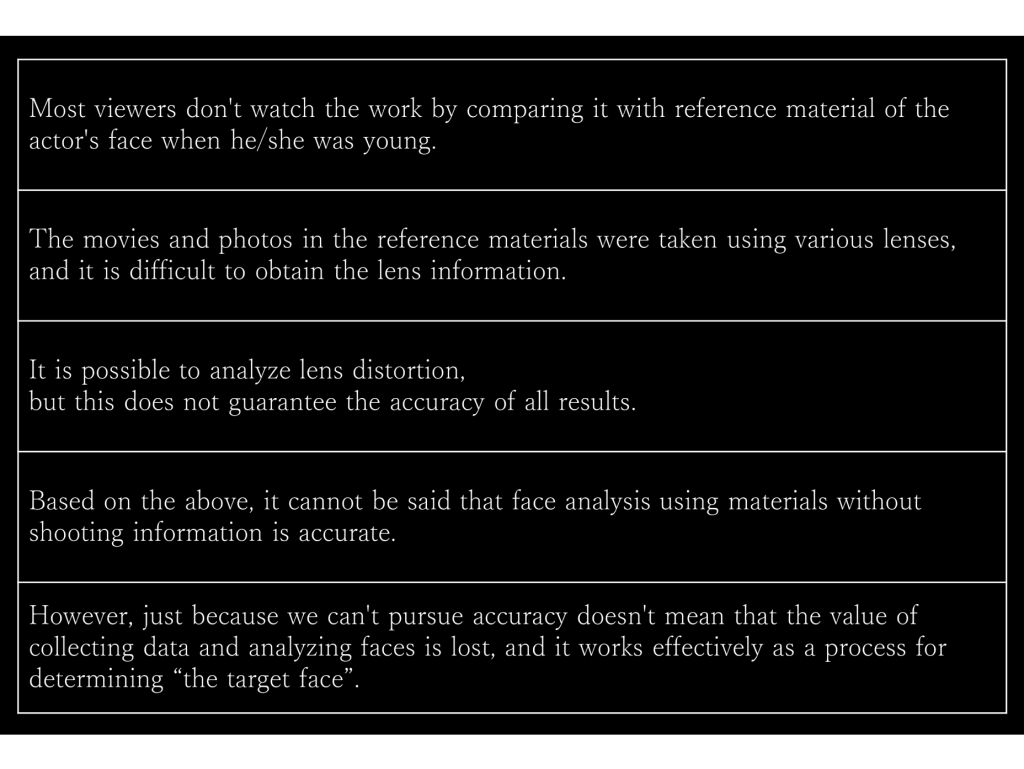
This “accuracy” has a significant impact on the total cost. The more you aim for “accurate analysis” and “accurate reproduction”, the higher the cost will be.
Even if the numerical values of the measurements of an actor’s face when they were young are accurate, it is important to consider that this does not necessarily mean that the viewer will give a good evaluation.
For this reason, we recommend that you prioritize making viewers and fans happy, and decide “how accurate you want to be?” during the process of the De-Aging VFX test work.
Finally, I would like to introduce how we use AI.
As we have staff who have been studying AI for four years, we have been trying and testing to see if we can use AI to support VFX artists.
Since we have been able to get AI to narrow down the hundreds of thousands of reference materials to less than 30 that are suitable for a particular shot, the burden on the artists has been reduced and they have more time to spend on their work.
Although more data is better, you can probably imagine how difficult it is to choose the best from among several hundred thousand items.
We can also have the AI learn from several hundred thousand data points and output the actor’s face when they were young. However, we only use the output as one of the reference materials that the artists can refer to. In other words, we don’t use the AI-generated images in the final product.
(We will talk about the reasons for this at another time.)
The “younger face” output by the AI is very useful. The AI does not have any attachments, prejudices or biases towards the data. It is difficult for us humans to work without these things. The AI has become an important member of our facial VFX team.
Company
Digic Inc.
Gunma Bank Ikebukuro Building 3F 2-1-6 Ikebukuro, Toshima-ku, Tokyo 171-0014 Japan
Phone: +81-3-5860-2533
Email: eizo@digic.jp
President & CEO Shinichiro KOBASHI
Established in March 2006
Nearest station to our office is Ikebukuro station.
